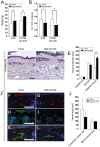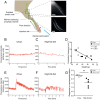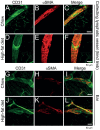Chronic high-fat diet impairs collecting lymphatic vessel function in mice
- PMID: 24714646
- PMCID: PMC3979858
- DOI: 10.1371/journal.pone.0094713
Chronic high-fat diet impairs collecting lymphatic vessel function in mice
Abstract
Lymphatic vessels play an essential role in intestinal lipid uptake, and impairment of lymphatic vessel function leads to enhanced adipose tissue accumulation in patients with lymphedema and in genetic mouse models of lymphatic dysfunction. However, the effects of obesity on lymphatic function have been poorly studied. We investigated if and how adipose tissue accumulation influences lymphatic function. Using a lymphatic specific tracer, we performed in vivo near-infrared (NIR) imaging to assess the function of collecting lymphatic vessels in mice fed normal chow or high-fat diet (HFD). Histological and whole mount analyses were performed to investigate the morphological changes in initial and the collecting lymphatic vessels. HFD was associated with impaired collecting lymphatic vessel function, as evidenced by reduced frequency of contractions and diminished response to mechanostimulation. Moreover, we found a significant negative correlation between collecting lymphatic vessel function and body weight. Whole mount analyses showed an enlargement of contractile collecting lymphatic vessels of the hind limb. In K14-VEGF-C mice, HFD resulted in a reduced spreading of the tracer within dermal lymphatic vessels. These findings indicate that adipose tissue expansion due to HFD leads to a functional impairment of the lymphatic vasculature, predominantly in collecting lymphatic vessels.
Conflict of interest statement
Figures




References
-
- Brorson H, Ohlin K, Olsson G, Karlsson MK (2009) Breast cancer-related chronic arm lymphedema is associated with excess adipose and muscle tissue. Lymphat Res Biol 7: 3–10. - PubMed
-
- Harvey NL (2008) The link between lymphatic function and adipose biology. Ann N Y Acad Sci 1131: 82–88. - PubMed
-
- Harvey NL, Srinivasan RS, Dillard ME, Johnson NC, Witte MH, et al. (2005) Lymphatic vascular defects promoted by Prox1 haploinsufficiency cause adult-onset obesity. Nat Genet 37: 1072–1081. - PubMed
Publication types
MeSH terms
Substances
LinkOut - more resources
Full Text Sources
Other Literature Sources
Molecular Biology Databases
Miscellaneous

